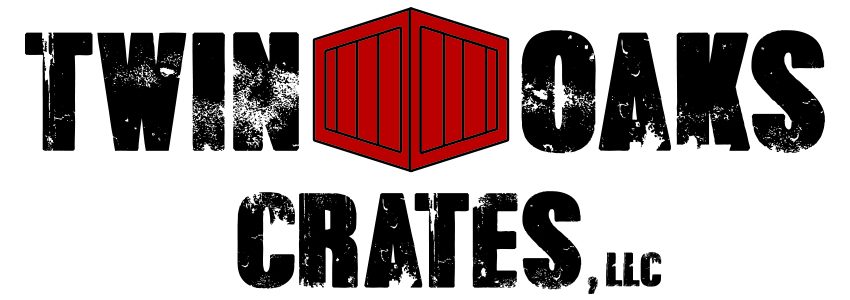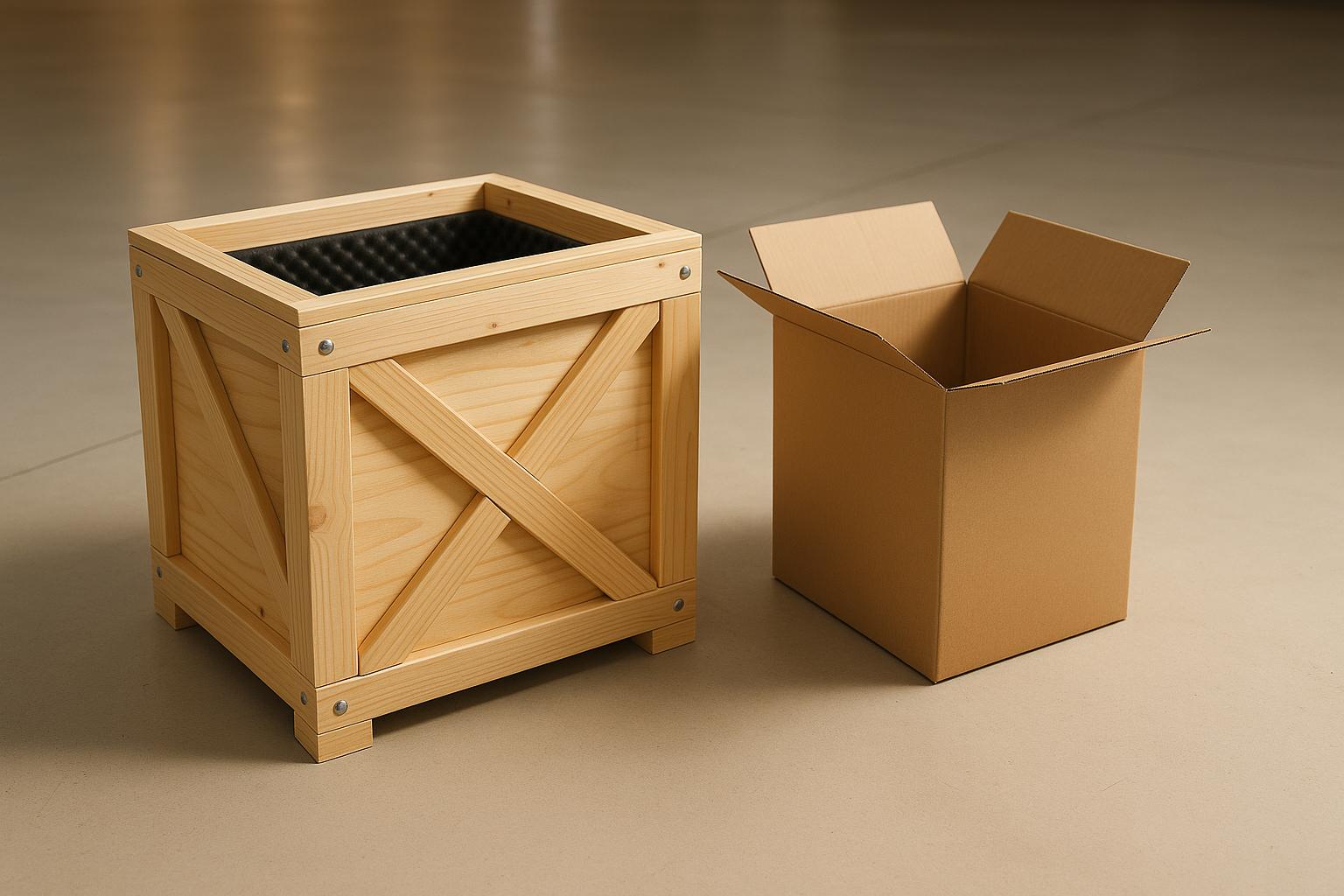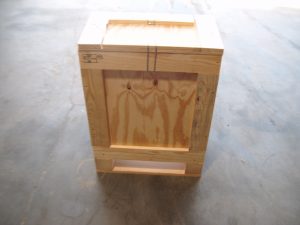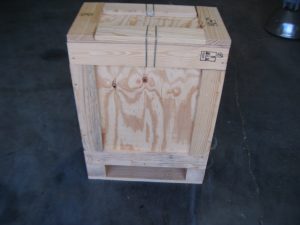When deciding between custom wooden crates and standard cardboard boxes for shipping, your choice depends on factors like durability, cost, protection, and compliance. Here’s a quick breakdown:
- Custom Wooden Crates: Designed for heavy-duty protection, high-value or fragile items, and international shipping. They handle rough conditions, meet ISPM 15 standards, and can be tailored to specific needs but are more expensive upfront.
- Standard Cardboard Boxes: Budget-friendly, lightweight, and suitable for general use and short distances. While cost-effective, they offer less protection and are unsuitable for heavy or fragile shipments.
Quick Comparison:
| Factor | Custom Wooden Crates | Standard Cardboard Boxes |
|---|---|---|
| Durability | Handles heavy loads and harsh conditions | Limited to lighter, everyday use |
| Protection | High protection from shocks and weather | Moderate, less suited for fragile items |
| Cost | Higher upfront, lower long-term risk | Low upfront, higher risk of damage |
| Compliance | Meets international standards (ISPM 15) | Not compliant for international shipping |
If you’re shipping fragile, high-value, or international items, custom crates are worth the investment. For lighter, less sensitive goods, standard boxes are a cost-effective solution.
Custom Wooden Shipping Crates & Freight Boxes
Custom Wooden Crates: What They Offer
Custom wooden crates provide sturdy protection, even in tough shipping environments. Their strength comes from the careful selection of materials tailored to meet specific shipping needs.
Materials and Strength
The foundation of high-quality wooden crates lies in the materials used. Hardwoods like oak, maple, and birch are known for their durability and resistance to impact. These qualities make them perfect for shipping heavy or valuable items like machinery, automotive parts, or other equipment that must remain undamaged during transport.
For shipments where weight is a concern – such as air freight – softwoods like pine, spruce, and fir are excellent alternatives. They are lighter but still provide effective shock absorption, making them a practical choice.
Plywood, with its layered veneer construction, offers another option. It resists warping while balancing strength and weight. This makes it especially useful for air freight, where maintaining structural stability without adding unnecessary weight is critical.
Standard Boxes: What They Offer
Standard boxes provide a practical and cost-effective solution for shipping and storage needs across the United States. Their design and materials make them a staple in warehouses and logistics operations.
Materials and Build
Most standard boxes are made from corrugated fiberboard, a material known for its lightweight yet strong construction. The fluted structure not only adds durability but also reduces the amount of material needed, cutting down on weight and shipping expenses. Interestingly, over 80% of these boxes are crafted from recycled materials, making them an eco-friendly option that also keeps costs manageable.
Affordable and User-Friendly
When it comes to cost, standard boxes shine. Their corrugated design can lower shipping expenses by as much as 20% compared to heavier packaging alternatives. It’s no wonder that 95% of shipments in the U.S. rely on corrugated boxes.
"Corrugated boxes are great for storing and shipping because they save you money. They’re made from recycled paper, which keeps costs down." – The Boxery Team
In warehouses, these boxes excel thanks to their stackable nature and standardized sizes, which maximize vertical storage and simplify inventory management. Their simple design means no special tools or extensive training are required for assembly, making them a go-to choice for one-time shipments or storing non-fragile items. However, while they offer affordability and convenience, they aren’t perfect for every situation.
Limitations to Consider
Despite their advantages, standard boxes have their drawbacks. Their lightweight construction makes them less suited for heavy or high-value shipments, as excessive weight can compromise their structural integrity and put the contents at risk.
"Corrugated boxes offer a unique combination of affordability and performance, making them an ideal choice for businesses prioritizing value." – Radhesham Wellpack
sbb-itb-1c2a65d
Side-by-Side Comparison: Custom Crates vs Standard Boxes
Here’s a closer look at how custom wooden crates stack up against standard boxes across key factors.
Comparison Chart
| Factor | Custom Wooden Crates | Standard Boxes |
|---|---|---|
| Durability | Built from materials like pine, oak, plywood, OSB, or hardboard to handle heavy loads without warping | Made of corrugated fiberboard, suitable for lighter, everyday use |
| Weight Capacity | Specifically designed to support heavy loads without buckling | Best for lighter items; prone to crushing under pressure |
| Protection Level | Shields contents from compression, drops, vibration, shock, and extreme temperature changes | Provides moderate protection for general use |
| Customization | Fully customizable with features like reinforced corners, internal bracing, and shock-absorbing elements | Offered in standard sizes with limited options for alterations |
The table outlines the major differences, but let’s dive deeper into how these factors influence your choice.
Breaking Down Each Factor
Durability and Strength
Custom wooden crates are made from sturdy materials like pine, oak, and plywood, designed to endure heavy-duty shipping and resist deformation under stress. On the other hand, standard boxes, crafted from corrugated fiberboard, work well for lighter loads but are far less durable when subjected to rough handling or heavy contents.
Protection Capabilities
When it comes to protection, wooden crates shine. They offer robust defense against compression, drops, vibrations, shocks, and even extreme temperature shifts. This makes them ideal for safeguarding fragile or complex items during transit. Standard boxes, while sufficient for general applications, fall short in harsher conditions and are more susceptible to crushing or collapsing under strain.
Customization Options
Custom crates allow for a range of tailored features, including reinforced corners, internal bracing, and shock-absorbing components, all aimed at enhancing stability and protection. In contrast, standard boxes come in fixed sizes and offer minimal flexibility for specific needs.
How to Pick the Right Option
Choosing the best packaging solution comes down to your specific shipping needs and weighing cost against protection. Let’s break down the main factors to consider when deciding on the right option for your shipment.
What to Think About
Item Value and Fragility
If you’re shipping high-value or fragile items, custom crates are worth the added expense. For example, delicate machinery needs tailored protection to avoid expensive damage. On the other hand, for everyday items that can handle minor impacts, standard boxes are a more cost-effective choice.
Shipping Distance and Handling
Long-distance shipments, especially international ones, face more handling and storage risks. Conditions can vary widely, making custom wooden crates a better choice for their durability and protection. For shorter, domestic trips with minimal handling, standard boxes often get the job done.
Environmental Conditions
If your shipment might encounter moisture, temperature swings, or rough handling, wooden crates with moisture barriers are a smart choice. Cardboard boxes, while economical, absorb moisture and lose strength when exposed to such conditions, making them less reliable.
Budget Constraints
Standard boxes are budget-friendly upfront but can lead to higher costs if damage occurs. Investing in custom crates may save you money in the long run by reducing repair or replacement expenses.
Compliance Requirements
Shipping internationally? You’ll need to meet regulatory standards. Many countries require wood packaging materials to comply with ISPM 15 certification to prevent pest contamination. Custom wooden crates can be built to meet this certification, simplifying customs clearance. Standard boxes, however, usually don’t meet these requirements.
Twin Oak Crates, LLC Services
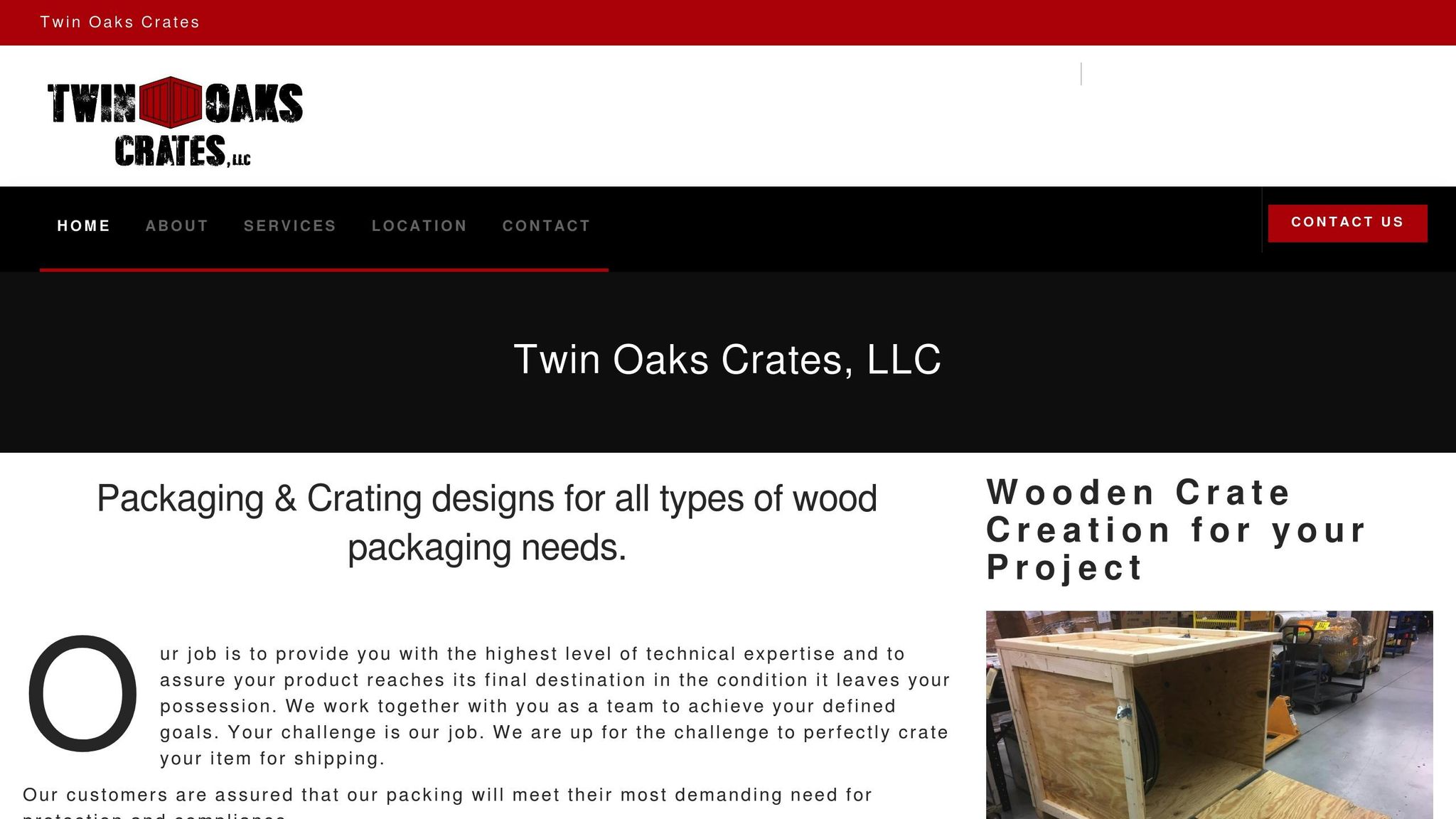
Twin Oak Crates, LLC offers solutions tailored to meet these challenges. Their custom wooden crates are designed to fit your exact shipping needs, whether you require reinforced corners for heavy machinery or specialized bracing for fragile equipment.
With ISPM 15 certification, Twin Oak Crates ensures your international shipments meet global regulations, helping you avoid customs delays. They also provide vapor barrier services, adding moisture protection with desiccant bags – ideal for sensitive electronics or precision instruments exposed to humidity.
For added convenience, their digital crate design service allows you to preview your custom packaging before production begins, ensuring it matches your specifications. Prefer to let the experts handle everything? Twin Oak Crates offers on-site packaging services at your location or pick-up services where packaging is completed offsite.
Need a quicker option? They maintain a stock of pre-made wooden crates. These ready-to-use crates offer the same durability and protection as custom options but with reduced lead times, perfect for urgent shipments.
When deciding on your packaging solution, Twin Oak Crates provides the expertise to help you strike the right balance between protection, compliance, and cost-efficiency. Their services ensure your shipments are secure and meet all necessary standards, no matter where they’re headed.
Final Thoughts on Packaging Decisions
When it comes to packaging, it’s all about choosing the right option to match your shipping needs. Each type of packaging has its own strengths, and understanding these can help you make smarter decisions for your cargo.
For lightweight, non-fragile items traveling short distances, standard boxes are a practical choice. They’re cost-effective, easy to find, and ideal for shipments where the risk of damage is low.
On the other hand, custom wooden crates shine in situations where shipping conditions are more demanding. They’re built for durability, can withstand harsh weather, and meet international standards like ISPM 15. While they come at a higher price, their ability to minimize damage makes them worth the investment for fragile or high-value cargo.
Your decision should always consider key factors like the fragility and value of your items, the shipping distance, potential environmental challenges, budget constraints, and any regulatory requirements. For international or sensitive shipments, custom crates provide the protection and compliance needed to ensure safe delivery. Companies like Twin Oak Crates, LLC specialize in this area, offering tailored solutions that balance cost and protection.
Twin Oak Crates, LLC stands out with its expertise in creating packaging that meets both protection and budget needs. Their ISPM 15 certification ensures hassle-free international shipping, while additional services like vapor barrier protection and digital crate design provide a level of customization that adapts to complex shipping challenges. Whether you need ready-made stock crates or fully customized designs, they deliver solutions that prioritize safety, compliance, and cost-efficiency.
Ultimately, the right packaging choice ensures your items arrive safely, meet regulations, and avoid unnecessary delays or expenses. Taking the time to assess your shipping needs can save you time, money, and headaches down the road.
FAQs
What are the benefits of using custom wooden crates for international shipping instead of standard cardboard boxes?
Custom wooden crates are built to handle the toughest shipping challenges, making them perfect for transporting heavy, delicate, or high-value goods across long distances. Unlike regular cardboard boxes, these crates are designed to endure the bumps and stresses of international travel, offering a much lower chance of damage along the way.
What sets wooden crates apart is their ability to be customized to fit specific sizes and weights. This ensures your items are snug and secure while also maximizing space efficiency. Plus, they meet international shipping standards like ISPM 15, which is crucial for hassle-free customs clearance. On top of that, wooden crates can be reused multiple times, making them an eco-friendly and budget-conscious option for shipping.
How does the type of wood used in custom crates affect their performance and suitability for shipping?
The type of wood you choose for custom crates is a big factor in how well they hold up during shipping. Hardwoods like oak and maple are known for their durability and ability to withstand impact, making them a solid choice for heavy or delicate items that need extra care. Meanwhile, softwoods such as Southern Yellow Pine are lighter and more budget-friendly, offering decent strength while being easier to handle.
That said, wood has its challenges – moisture can weaken it over time. Opting for treated or engineered wood can make a difference, offering better resistance to moisture and other environmental factors. Ultimately, selecting the right wood comes down to what your shipment needs: its weight, how fragile it is, and the conditions it will face during transit.
When does it make sense to choose custom wooden crates over standard cardboard boxes?
Custom wooden crates are an excellent option for shipping heavy, fragile, or high-value items that need extra protection. Their sturdy design minimizes the risk of damage during transit, making them a reliable choice for delicate or expensive goods.
These crates are also a smart investment if reusability is a priority. Unlike single-use cardboard boxes, wooden crates can be used repeatedly, offering durability over the long term. Plus, their custom sizing ensures a perfect fit for your items, while allowing for efficient stacking, which can streamline both storage and shipping. Though the initial cost may be higher, the durability and tailored features of wooden crates often translate into long-term savings and improved efficiency.
